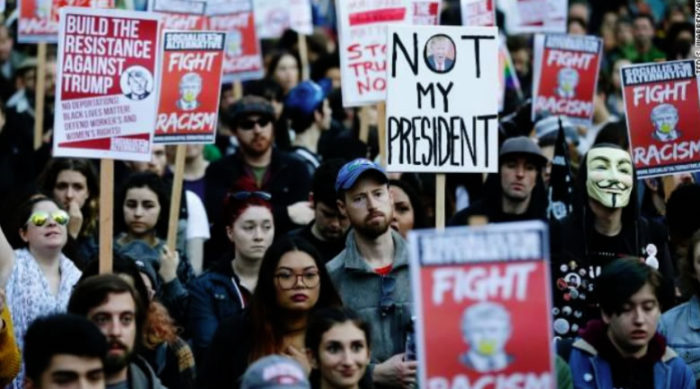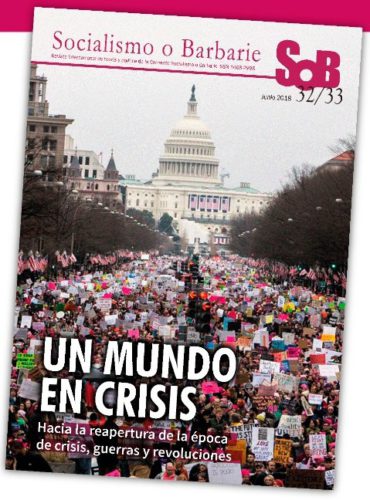
By the closing of story -22.00 local time- syrens still resound in downtown Washington DC. President Donald Trump’s inaugural ceremony has ended several hours ago and protesters still march the streets of the US Capital, besieging rightwing balls with blockades, piquet lines, rallies and demonstrations.
From early on the city was mobilized, combining a wide array of slogans and demands: Against xenophobia, racism and white supremacism chanting ‘Black Lives Matter’, ‘No Trump, no KKK, no fascist USA’ or ‘No shame, no fear, inmigrants are welcome here’. Against patriarchy and for women’s and LGBT rights, raising demands against machismo and discrimination, and for legalized, safe abortion.
How did Donald Trump manage to unify all this demands against him? It’s not just his openly racist, patriarchal and regressive campaign as he was running for office, embodying things like a fortified wall in the border with Mexico, or ‘pussygrabs’, but the fact that, as the moment of his formal inauguration (12.00 local time) drew closer, a realization seemed to dawn on people that all those promises would become a reality unless resisted.
As if his war-cabinet, full of billionaires, supremacists and warmongers wasn’t enough, the real estate tycoon’s inaugurational speech made things even clearer. In the 17 minutes he took to address the american people, Trump managed to stage a revival of the theory about the US’ ‘manifest destiny’ to lead all the world’s affairs, just in a much more regressive, nationalistic key.
“For many decades, we’ve enriched foreign industry at the expense of American industry; Subsidised the armies of other countries while allowing for the very sad depletion of our military; We’ve defended other nation’s borders while refusing to defend our own” he snapped in front of a heavily guarded audience, besieged by blockades and demonstrations.
This idea, to victimize the US as a naive altruistic country is in line with Trump’s demagogic rhetoric during his campaign, the same he uses to tell the working class that their suffering is to be blamed in a bad, somewhat too generous, previous administration. But nothing could be further from the truth, both president Bush and Obama have developed international trade agreements and military interventions exclusively in the US’ interest, invading countries and destroying economies and societies alike to benefit the US Dollar.
After the 2007/08 financial crisis and Obama’s bailout of the big financial institutions, the pillars of the world’s imperialist system managed to avert a crisis but were unable to reactivate the world’s economy. Now Trump, demagogy aside, is proposing an out: A radical rightward shift towar national-imperialism, economic protectionism and trade war to generate some kind of domestic growth. With a patriotic, ultra nationalistic (America first), militaristic and religious rhetoric, this shift poses a great threat to dependant economies, like we’re seeing nowadays in Mexico.
This shift in the handling of international affairs brings about tension and geopolitical uncertainty in the high spheres of power, as exemplified by chinese Premier, Xi Jinping’s concerns at the World Economic Forum. But down below, the rank and file took their chance to express themselves in a whole week of protests in DC and the rest of the US, which reached a whole new level in the #Disrupt20J demonstrations and which promises to go even further tomorrow in the Women’s March on Washington, with an announced attendance of over 200.000 people.
Today’s activities began early in the morning, with rallies in different squares and from there small groups departed to blockade access points for Trump’s inaugural ceremony. At around 10 AM people began marching from different rally points, converging in Union Station, just a few blocks away from the Capitol. The official march seemed over but protesting carried on, heading back to the city center and at around 15.00, while the presidential parade was taking place, marches and demonstrations filled the streets around the White House area.
As columns grew in number and drive, and the notion that Trump was already officially president of the United States set in, the anger and disgust radicalized rapidly, with groups smashing windows of banks and international stores, and clashing with riot police throughout the city. At around 16.00 several streets had turned into small battlezones, revolving around 12th and K streets, which rapidly became trending topic and kept attracting more and more protesters.
Finally security forces managed to split up the protest in several pieces scattered in different corners, but two hours went by and the crowd regrouped in Franklin Square where, as a music festival was taking place, a crowd of about 1000 people kept riot police at bay for several hours.
As soon as the demonstration began scattering, police charged back pepper spraying and making arrests. Though the groups that broke off the main protest began to form small marches wandering around the city in search of republican balls to pester or new rallies to join.
This elements of spontaneity and disorganization, caused by the decentralization to which most organizations contributed, proved to be serious limits when it came to facing police repression or establishing an orderly resistance; However, on the other side they also show that, at least in a vanguard level, the are great reserves of anger and stamina to fight back.
Moreover, these persistent factors of struggle and morale varnished an unprecedented presidential inauguration, with protests far bigger, longer and more persistent than those seen on Nixon or Bush’s inaugurations.
Tomorrow the much anticipated Women’s March on Washington promises to be much more massive and centralized. Should that combine with the combatant elements seen today, it’d be a blunt and clear message to president Trump, that he won’t be able to easily carry on his reactionary agenda, that austerity, repression and discrimination will be resisted.
Correspondent from Washington for Socialism or Barbarism


